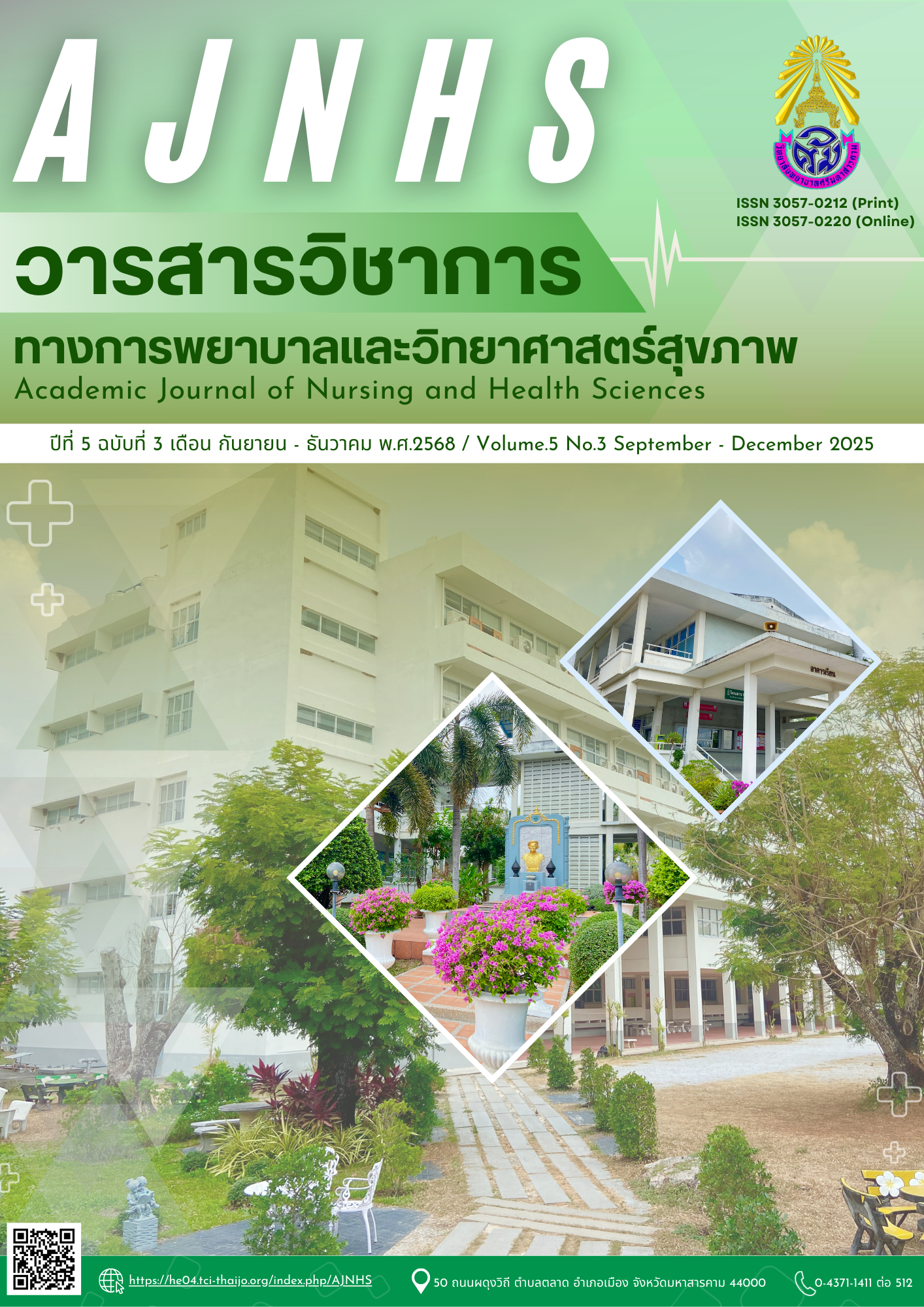The Effectiveness of a Self-Care Health Education Program for Pregnant Women via Telehealth service system at Tha Uthen Hospital, Nakhon Phanom Province
Keywords:
Pregnant, Health education program, Telehealth service systemAbstract
This quasi-experimental study aimed to examine the effectiveness of a self-care health education program for pregnant women through a telehealth service system at Tha Uthen Hospital, Nakhon Phanom Province. The research employed a two-group pretest-posttest design. The participants were 62 pregnant women receiving antenatal care services at Tha Uthen Hospital between March and September 2025, divided equally into an experimental group (n = 31) and a control group (n = 31). The research instruments consisted of (1) a general information questionnaire, (2) a self-care perception questionnaire for pregnant women, and (3) a self-care health education program for pregnant women through a telehealth service system. Data were analyzed using descriptive statistics, including frequency, percentage, mean, and standard deviation, and inferential statistics, including the Paired Sample t-test and Independent Sample t-test, with a significance level set at .05.
The results revealed that after participating in the program, pregnant women in the experimental group had significantly higher mean scores of self-care perception than before the intervention and compared to the control group (p < .05) in all aspects, including nutrition and medication use, pregnancy complications, and recognition of danger signs. Moreover, participants were able to apply the acquired knowledge in their daily self-care practices effectively.
In conclusion, the self-care health education program for pregnant women delivered through a telehealth service system was effective in enhancing knowledge, awareness, and appropriate self-care behaviors among pregnant women. The program can be implemented in antenatal clinics at community hospitals to improve the quality of maternal and child health services at the local level efficiently and sustainably.
References
กรมอนามัย. (2567). รายงานสถานการณ์การตายมารดา เขตสุขภาพที่ 8 และจังหวัดนครพนม ปีงบประมาณ พ.ศ. 2562–2567. กองอนามัยการเจริญพันธุ์ กรมอนามัย กระทรวงสาธารณสุข. สืบค้นเมื่อ 10 ตุลาคม 2567 จาก https://dashboard.anamai.moph.go.th/dashboard/mmr
จารุวรรณ เย็นเสมอ, และคณะ. (2564). การพัฒนาระบบบริการเครือข่ายแบบห้องคลอดเดียวกันเพื่อแก้ไขปัญหาการตายมารดาจากสาเหตุที่ป้องกันได้ (มีการใช้ Tele-Line Consulting System). วารสารศูนย์อนามัยที่ 9, 15(36), 138–148.
ตติรัตน์ เตชะศักดิ์ศรี, และคณะ. (2560).แบบจำลองเชิงสาเหตุคุณภาพชีวิตของหญิงตั้งครรภ์.วารสารเครือข่ายวิทยาลัยพยาบาลและการสาธารณสุขภาคใต้, 4(1), 28-46.
ธันยพร ศรีวงค์ชัย, และคณะ. (2566). การประยุกต์ใช้นวัตกรรมแอปพลิเคชัน “มาม่า” บนโทรศัพท์มือถือเพื่อส่งเสริมสุขภาพหญิงตั้งครรภ์. วารสารวิทยาลัยพยาบาลบรมราชชนนี สุราษฎร์ธานี, 35(2), 45–60.
บุญชม ศรีสะอาด. (2545). พื้นฐานการวิจัยทางพฤติกรรมศาสตร์. กรุงเทพฯ: สุวีริยาสาส์น.
รุจิพัชญ์ เพ็ชร์สินเดชากุล, และสาริศา สืบจากดี.(2567). ผลของโปรแกรมการให้คำปรึกษาการตรวจคัดกรองกลุ่มอาการดาวน์ซินโดรม ในหญิงตั้งครรภ์ โรงพยาบาลส่งเสริมสุขภาพ ศูนย์อนามัยที่ 3 นครสวรรค์.วารสารการส่งเสริมสุขภาพและอนามัยสิ่งแวดล้อม, 47(ฉบับเพิ่มเติม), 11-25.
ละออง บุตรศาสตร์. (2567). ผลของโปรแกรมสร้างเสริมความรอบรู้ด้านสุขภาพต่อความรู้และการปฏิบัติตัวของหญิงตั้งครรภ์ครั้งแรก โรงพยาบาลหนองพอก จังหวัดร้อยเอ็ด. วารสารวิจัยและพัฒนานวัตกรรมทางสุขภาพ,5(3), 368–379.
ศจี สงจันทร์, และคณะ. (2566). พฤติกรรมการใช้แอปพลิเคชันไลน์ “9 ย่างเพื่อสร้างลูก” ในหญิงตั้งครรภ์ ศูนย์อนามัยที่ 7 ขอนแก่น. วารสารศูนย์อนามัยที่ 7, 15(1), 79–91.
ศูนย์อนามัยที่ 8 อุดรธานี. (2567). รายงานสรุปการทบทวนการตายของมารดา (Maternal Death Review) เขตสุขภาพที่ 8 ปีงบประมาณ 2562–2567. กรมอนามัย กระทรวงสาธารณสุข.
สุวดี พลน้ำเที่ยง, และคณะ. (2568). การพัฒนารูปแบบการติดตามดูแลสตรีตั้งครรภ์เสี่ยงโดยใช้ Telehealth ในเครือข่ายบริการแม่และเด็ก. วารสารการพยาบาล สุขภาพ และการศึกษา, 8(1), 38 –51.
สุวรรณอำไพ, และคณะ. (2566). ผลของโปรแกรมการให้ความรู้โดยใช้โมบายแอปพลิเคชันต่อความรอบรู้ด้านสุขภาพของสตรีตั้งครรภ์. Thai Journal of Nursing Council, 38(2), 65–79.
World Health Organization. (2020). Trends in maternal mortality 2000 to 2020: Estimates by WHO, UNICEF, UNFPA, World Bank Group and UNDESA/Population Division. WHO.
Downloads
Published
How to Cite
Issue
Section
License

This work is licensed under a Creative Commons Attribution-NonCommercial-NoDerivatives 4.0 International License.

